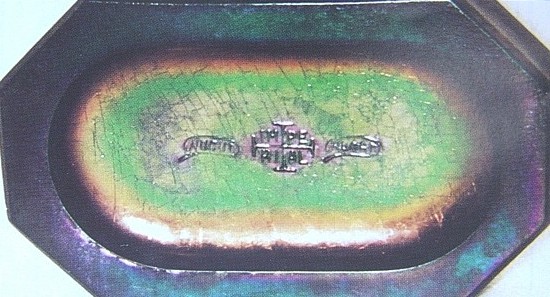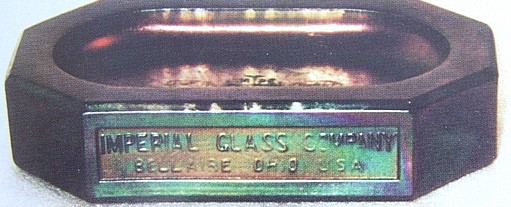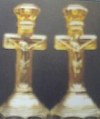Advertising Pieces - Non-Standard
NON-STANDARD-SIZED ADVERTISING PIECES
While there are carnival glass examples of hat shapes, mugs, etc. having lettering along the sides, or on the base; for the purposes of our descriptions and emphasis in writing about Advertising and Commemorative pieces, we are only concerned with those examples having clearly legible lettering on the upside surface. Reverse side, painted or etched lettered pieces, nappies or bottle shapes with lettering are not dealt with.
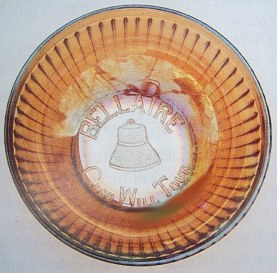
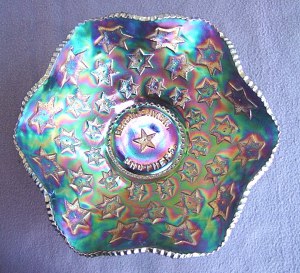
Left - BELLAIRE SOUVENIR
Right - BERNHEIMER BROTHERS
BELLAIRE SOUVENIR ~~ This bowl remains one of mystery among Imperial productions. These round 7” bowls carry a large molded bell in the center, surrounded by the lettering - “Bellaire - Good Will Tour.” The exterior is a Smooth Rib design. These pieces are quite scarce and known only in marigold. Bellaire, OH is known to be the home of Imperial Glass Co. Further extent of information about this piece continues to elude us. Obscure as they are, little notice has been given them. Not expensive in terms of prices realized for other advertising items, they are none-the-less attractive. Based on previous, but outdated sales reports, a “guesstimate” of up to $300 might be in the realm of reality for this elusive piece.
BERNHEIMER BROTHERS ~~ Established in 1884, Bernheimer Brothers was one of the first discount department stores in America. It grew rapidly by using cut-rate pricing and clever advertising schemes. On March 16, 1908 they moved their operations at 300 West Lexington, into a new six story building located at 302-306 West Fayette St. Baltimore, MD. Instituting a 600 seat restaurant, with full course dinners served for $.19, proved to be only one of the innovative features of the new building. A bowling alley, a vaudeville theatre with admission of $.05, and cows being milked by electronic milking machines to guarantee freshness, also created incentives for shopping!
In 1923, Bernheimer merged with Leader Stores to become Bernheimer-Leader. Eventually, that group in turn was sold to May Co. Stores in Sept. 1927 for seven million dollars. Many of us are familiar with the growth pattern of May Co. since that time, but alas, no more freshly milked cows are on premises!
This pattern is among several “star designs of note” from Millersburg production. The back pattern is called TREFOIL FINECUT. This pattern may be viewed in the segment :Millersburg Primary and Secondary Patterns.
This is essentially a Many Stars 10” bowl with addition of the lettering, and a small star replacing the larger star normally found in the center of the bowl. Blue is a rare color in Millersburg pieces, but all known examples of this pattern are found in blue base glass, considered to be very scarce.
One great example sold in Sept. 1997 for $3250.
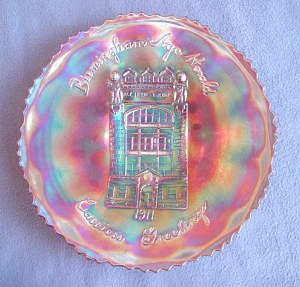
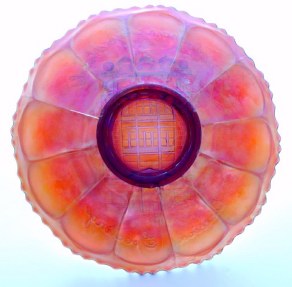
BIRMINGHAM AGE - HERALD Plate - Front and Back
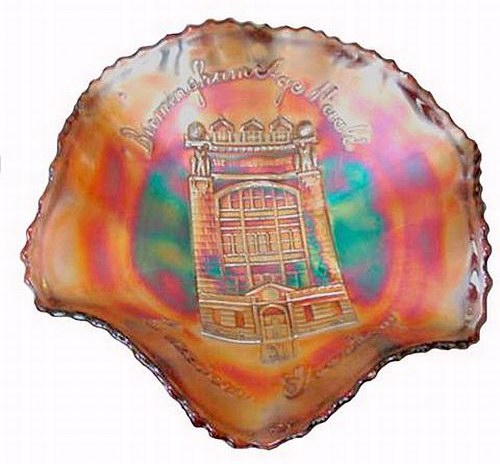
BIRMINGHAM AGE HERALD Bowl.- Amethyst.
BIRMINGHAM AGE - HERALD ~~ Founded in 1874, the Birmingham Age-Herald was a morning newspaper, surviving various ownerships until its demise in 1950. (The Age-Herald-Building stood at 2109 Fifth Ave. North; in Birmingham, Alabama.) These very desirable souvenir pieces were created for Christmas gifts to the news carriers. Lettering reads: 1911 CARRIERS GREETINGS. The Birmingham Post merged with the Age-Herald. Today, the Birmingham Post-Herald remains a Scripps Howard newspaper, published by the Birmingham Post Co., an Alabama corporation. On March 15, 1974, an article was run about the Age-Herald Bowl. That article is quoted as saying that only five bowls are left, worth a reported $3000 each! Mention was also made of an ad, which had appeared some years before, offering $300 for the purchase of any Age-Herald piece! Certainly, values and standards have risen in recent years. Collectors' credence for both the 9” amethyst bowls and 9 ½” plates supercedes those earlier estimates. These are rare specimens in any shape! An extremely beautiful plate example from the Adams' collection sold at a Seeck Auction for $2600 on 11/22/'03 in Wentzville, MO. In 2001, two others sold for $3100 and $2750. A bowl brought $3400 on 6/22/02 during a Mickey Reichel sale in Boonville, Mo. An unusual hand grip style plate sold for $2956 in 2000.
Addendum: (A John Resnik quote from info. included in his 1989 publication Encyclopedia of Carnival Glass Lettered Pieces . ) “Contrary to what has been written by virtually every author; this is not a Millersburg product. The edge, glass clarity, and iridescence are all so typical of Fenton, that I am unwavering in my conviction that this is of their manufacture. Hold an amethyst Detroit Elk (known to be Fenton) next to an Age-Herald and see if you can arrive at any other conclusion. At least in my own experience, there would appear to be more plates than there are bowls in this pattern. The desirability of the plate, however, has managed to maintain a considerable price edge.” (We concur with John's summation!) (Our personal plate example was purchased for us by a friend, Neal Smith, with a Birmingham “connection” in 1986.) Exterior carries the typical Fenton Wide Panel pattern.
IMPERIAL PAPERWEIGHT ~~ Specific reference to this item is not available in company documents or in catalogues illustrating Imperial production. NUCUT and NUART were registered trademarks from 1911 and 1914 respectively. The IM PE RI AL within the iron cross registered trademark was not granted until 1921. The twentieth anniversary of the formation of the company dated to 1921, and 1924 marked the twentieth anniversary of its first production. Perhaps the latter date is more significant and befitting a special souvenir to mark the importance of such accomplishment. Since so few examples exist, we could theorize that the pieces were probably made for presentation to a select few employees or stockholders who had succeeded in remaining with the company throughout those early growth years. Whether this item should be termed a commemorative or advertising piece, is the question? Certainly it fits the heading used for these non-standard pieces. We shall leave the rest up to you. Two of these paperweights have sold during 2003. One brought $950. The other $2500. The significant price difference very likely reflects the degree of damage present. This sales activity is published in the Sanctified Cross-Eyed Bear Price Trend Guide.
The scoop shape of the top indentation leads to possible use as a holder for paper clips. 5 3/8” x 3 ¼” x 1 1/8”, weighing in excess of one pound, making it perfect for use as a paperweight, as well. The iridization on the one or two examples we have seen over the years is all you would expect of purple Imperial. IMPERIAL GLASS COMPANY BELLAIRE OHIO USA is printed on the front side. IMPERIAL ART GLASS appears on the backside.
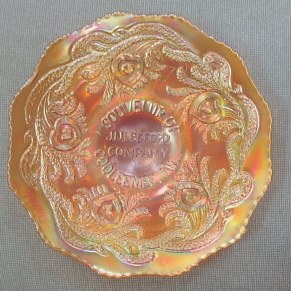
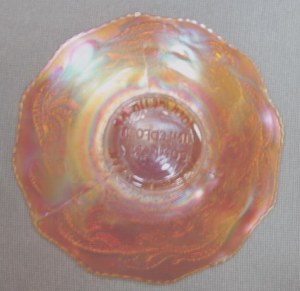
J.N. LEDFORD COMPANY COOLEEMEE, N.C - Front and Back.
J.N. LEDFORD COMPANY COOLEEMEE, N.C ~~ Since fewer than six of these marigold 9” plates are known, resultant prices when one does surface, are mind-boggling! During our years on the “trail”, we have seen but three for sale. All have been in auction settings. The first was in Hagerstown, MD in 1999. That example was of super status and sold to a PA collector for $15,000. Next one was at the HOACGA Convention auction in April 2000 when the price was $8000. The latest example sold during the Seeck sale of the Adams' Glass-Nov. 22, '03, realized $9000. The basic design is a Fenton Heart and Vine with the advertising added to the center portion of the plate. Exterior of these plates is without pattern. Surprisingly, these plates have come to be known as “Cooleemee Plate”, named for the place, rather than a J.N. Ledford Plate, for whom it advertises. J.N. Ledford Company was a company store for Irwin Mills, located near Winston-Salem in Northwestern North Carolina. Established in 1901, it carried a general line of merchandise for a rather captive clientele. An interesting sign of the times: An article about Cooleemee, concerning Irwin Mills and the Ledford Co. appeared in the local Journal periodical, dated Jan. 1, 1931. It stated that “Native Anglo-Saxons” were employed by these companies. As has been the case with many urban areas, the downtown portion of Cooleemee died a natural death in Dec. 1962, taking J.N. Ledford Company with it. The entire Main Street area was razed to build a parking lot in early 1963.
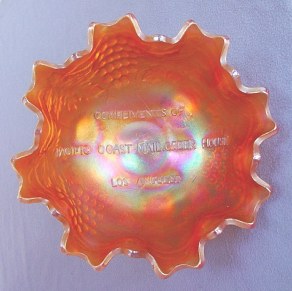
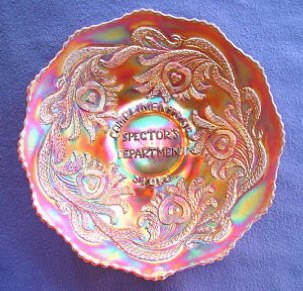
Left - COMPLIMENTS OF PACIFIC COAST MAIL ORDER.
Right - COMPLIMENTS OF SPECTOR'S DEPARTMENT STORE.
COMPLIMENTS OF PACIFIC COAST MAIL ORDER ~~ Certainly of unusual proportions, as compared to any of the other advertising pieces, this 10” Fenton Grape and Cable fruit bowl having COMPLIMENTS OF PACIFIC COAST MAIL ORDER HOUSE LOS ANGELES used for the interior plunger, presents itself to be the largest of any Advertising items. At the time John Resnik performed the exhaustive research for his Encyclopedia of Carnival Glass Lettered Pieces in 1989, he reported that the Los Angles Chamber of Commerce had no listing for this company. Local libraries showed no data. However, through a couple of print media advertisements, and an old telephone directory listing, a time frame of operations was established. J. C. Floyd established the Pacific Mail Order House at 229-231 South Los Angeles Street, Los Angeles, California in the year 1912. This enterprise was one of the first to offer Asian Imports nationwide on a mail order basis. Their stock in trade appears to have centered around clothing and novelty items. By 1917 the company had moved to 513 East 12th St., and after 1919 the company ceased to be listed. We are left to conclude that this was an ill-financed, fly-by-night operation. Never-the-less, they gave away some wonderful “souvenirs”!
John's book notes one blue example in “as-is” condition, in the Fenton Museum at that time, along with two marigold bowls. Only the bowl John owned at that time was “perfect”. The damage on the other specimen is a large sliver off the collar base and was in the hands of a non-collector. In addition: Our marigold bowl was purchased from an antiques dealer out toward Palm Desert, CA. She called to say she had just purchased it from a house sale. Naturally, we wanted it enough to drive there that same day in 1992. Not long after that, Judy Maxwell purchased a blue example in the Redlands, CA area. In February 1994, Fred Roque purchased a marigold bowl, which he ultimately sold for $3800. A green bowl was reported found in Colorado in June 1995. In January 1996, Judy Maxwell found a marigold bowl, and sold it in February 1996 for $2000. At last count, Elvis Randell of Oklahoma owned a marigold example. As recently as April 2002, Judy Maxwell had a blue bowl in her possession. How many of those listed here are repeat references is anyone's guess. Probably not more than six bowls exist in the combined colors. The base mold is the same three-footed version seen periodically with the Persian Medallion interior, and sometimes having no interior design at all. There has been no recorded sale of this pattern during 2003.
COMPLIMENTS OF SPECTOR'S DEPARTMENT STORE ~~ This offers further use of the 9” Heart and Vine pattern from Fenton. Only the lettering in the center of the plate suggests alteration. The exterior is smooth, as it is on the Cooleemee plates.
Most of the research for this advertising piece was accomplished by the late, great and memorable Randy Smith, dutiful member of the Keystone Carnival Glass Club of PA. The information was first published in that Club newsletter dated December 1988. John Resnik gave credit to Randy for allowing him to ride along on his coattail. Earlier laid groundwork is so very beneficial in updating information on any piece of carnival glass. Early researchers are to be congratulated for “sparking interest” in follow-ups.
Originally called Hetrick's Department Store, the two story framed building was a much needed addition to this small rural town in the south western portion of Pennsylvania. The building later became Spector's, built in 1891 by Arthur Hetrick at 6 East Franklin Street in New Freedom, PA. In 1901 Murice Spector acquired the business and renamed it after himself. Chronology not available, we place the time to be around 1910 when these plates were given away to Spector's customers as Christmas gifts. Would not Mr. Spector be somewhat “flabbergasted” at the desirability of his holiday largess by collectors today?
Later years saw store ownership in the hands of Isaac Morris, then by Moul & Davis. In turn the building has housed an Acme Food Store, Kiser, and then New Freedom Dept. Stores. At the time Mr. Resnik correlated information for his book, the building housed a dance studio on the first floor and a video store on the second. (Our plate example was purchased from the collection of Swede Tilberg in 1997).
Individual sales activity for this plate, generated over the past four years, will be reflected in the forthcoming price guide produced by Don and Lynda Grizzle. Based on their cumulative figures, from 2000-2003, thirteen examples have sold at prices ranging from $800-$2100. These fluctuations indicate several factors present: competitive bidding, iridescent quality, damage, even distribution of color over the surface of the plate, etc. Each collector has personal criteria to be met in their selections.
Summation: Like no other study, these insights into carnival glass specialty items offer historic documentation surrounding each design. The effect of their presence on the business world is still being felt nearly a century after the fact! Whether you care to collect these “treasures of the past” is entirely a personal decision. Those of us who do so with fervor and delight sincerely hope you, at least, will give them a second and more thorough glance! They indeed offer a great pleasure!
Dean & Diane Fry~~~~12/03
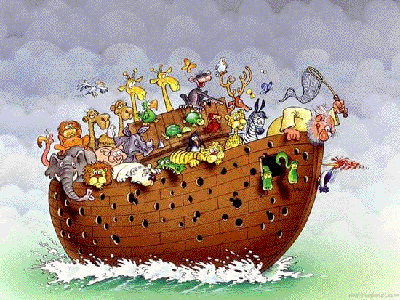
The woodpecker might have to go...................
Everything I need to know about life, I learned from Noah's Ark... One: Don't miss the boat. Two: Remember that we are all in the same boat. Three: Plan ahead. It wasn't raining when Noah built the Ark. Four: Stay fit. When you're 600 years old, someone may ask you to do something really big. Five: Don't listen to critics; just get on with the job that needs to be done. Six: Build your future on high ground. Seven: For safety sake, travel in pairs. Eight: Speed isn't always an advantage. The snails were on board with the cheetahs. Nine: When you're stressed, float a while. Ten: Remember, the Ark was built by amateurs; the Titanic by professionals. Eleven: No matter the storm, when you are with God, there's always a rainbow waiting..
NOW, wasn't that nice?
Should you care to contact the Frys, their email address is:
Search Our Sites
back to Carnival Glass 101
Our other sites you may enjoy:
Everything you EVER wanted to know about Indiana Glass
Great Reference for Newer Carnival Glass.
Complete Glassware Catalogs Available to Download
Questions? Comments? Suggestions? Broken Links? Corrections?
Your Friendly Webmaster is here to help!
